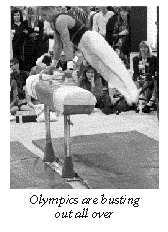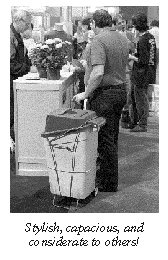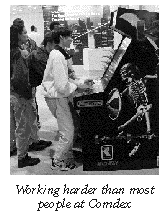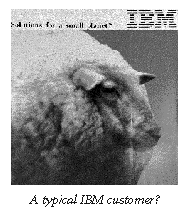
|
|
|
|
|
|
|
|
|
|
The looting was over before I got there, but downtown Atlanta still had the aura of metropolitan Sarajevo, with bombed-out buildings everywhere. Thankfully, it wasn't ethnic cleansing that created the war-zone feel, but two much more wholesome and American traditions: college partying and Olympic boosterism.
The looting was a malignant outgrowth of a yearly college Spring Break festival called "Freaknik." The student rowdiness got out of hand and lead to a bit of pillaging at a shopping center called "Underground Atlanta." Several stores were completely emptied, with the worst-hit being, oddly, purveyors of high-priced athletic footwear.
On the first day of Comdex, the downtown section of Peachtree Street was still lined with metal police barriers, relics of the late Freaknik. It was fun to imagine that the barricades were there to prevent frustrated convention-goers--inevitably dubbed "Geekniks" by the local DJs--from rioting about the ever-more-delayed-and-pruned Windows 95. Think of it: a horde of pasty, Saab-driving programmers, fueled by fermented Snapple and imported lager, burning an effigy of Bill Gates and then looting the Egghead Software store. Who says computer people are no fun?
 It is completely impossible to spend any time in Atlanta
and not be aware that the Olympics are coming in 1996. It's not because
you can already buy Olympic souvenirs as soon as you arrive at the
airport, though of course you can; it's the construction. More aptly,
it's the destruction.
It is completely impossible to spend any time in Atlanta
and not be aware that the Olympics are coming in 1996. It's not because
you can already buy Olympic souvenirs as soon as you arrive at the
airport, though of course you can; it's the construction. More aptly,
it's the destruction.Hartsfield International Airport is already well-known among travelers as the only major American airport completely conceived and designed by Satan. Anyone who has ever tried to make a connection from Gate A23 to Gate D1 understands the horror of the place. Every year a certain number of innocent vacationers are simply consumed by the airport, never to be seen again, though casualty figures are kept quiet. Others break down trying to find the mysterious and ever-moving T concourse in time to catch their international flights; uniformed personnel discreetly escort them away. Your baggage, if it arrives, often seems subtly changed: the same clothes and toiletries, yet not the same.
Now imagine the same hungry labyrinth undergoing major renovations to accomodate thousands of Olympic althletes, spectators, press, and logistics personnel. Escalators are blocked "to serve you better." New blank walls appear in unexpected places. Signs are covered with two or three layers of contradictory corrections. Traffic and pedestrians are funnelled into narrow temporary passages. Construction workers lounge everywhere on perpetual break.
Leaving the Hartsfield International Horror is usually a distinct relief. No longer. Everywhere buildings have been blown up to make room for new sports venues. Pavement is torn up. City DPW trucks block lanes to make snacking and sunbathing more convenient for their crews. Orange "Detour" signs mottle Atlanta like spots on a jaguar.
A press credential comes with an inexpensive tote bag and a formidable amount of promotional material. The key benefit, though, is access to the Media Lounge. This is a largish room with tables, chairs, and free refreshments. Anyone who has been to Comdex knows how precious a chair is, let alone a place to sit and collect your thoughts. The astute Media-enabled convention-goer can purchase a genetically engineered minipizza and retreat to the peaceful sanity of the Media Lounge, there to dine in peace, soothed by the susurration of foreign journalists muttering in their mysterious tongues.
The only fly in the ointment is the fact that some of the people who apply for media credentials are a little, well, peculiar. One that comes to mind is the gentleman who had something to say about the Vietnam War. This person, speaking--apparently to an invisible companion--in a tone audible to anyone within a four-block radius, explained in great detail that "we" "lost" the war only because the treacherous U. S. Congress refused to vote funds for enough bullets. Why "we" were there, and what "we" would have done had we "won," didn't seem to be important. I can only imagine what the Asian reporters made of this very ugly American... were any of them from Vietnam?
 Part of the fun in going to Comdex is seeing how The Next
Big Thing becomes Yesterday's News. One year it was Personal Digital
Assistants. Another time, even the mouse pads were Object Oriented.
Part of the fun in going to Comdex is seeing how The Next
Big Thing becomes Yesterday's News. One year it was Personal Digital
Assistants. Another time, even the mouse pads were Object Oriented.Last fall, it was the Internet, more specificially the World Wide Web. Everybody had a Web page, and every booth had an Internet Web browser on display. How the mighty have fallen! I knew the party was over when I saw the guy wearing the "http: THIS!" T-shirt.
The computer industry prides itself on being ahead of the curve. If the phrase "bleeding edge" didn't emerge from a computer user, it certainly should have. Now the public--the hoi polloi, the unwashed, the people who call tech support--is crazy about the Internet and the "Information Superhighway," so we of the intelligentsia don't dare show any interest. Just the jaded sigh.
Plenty of people who've been there are sighing. I heard one Web-authoring vendor say to a customer, "The Internet is a big black hole for money. Everybody spends a fortune getting on the Web, then they figure out that people can look at your stuff for nothing. They realize that people who have lots of time to screw around on the Web are either college students or terminal geeks. Not people with money to spend." A surprisingly honest and refreshingly cynical statement from a vendor, I must say.
From the near-total Internet blackout at Comdex, I would say the Information Superhighway bubble is about to burst. People have been Web-surfing long enough to realize that for every grain of useful information, there's a whole Malibu Beach of plain old junk.
The sure omen of a market about to collapse is when outsiders who don't really understand what they're getting into start trying to keep up with the Joneses. One newspaper spends a million dollars setting up a Web page because they're afraid to be "left behind by the information revolution." Then all the other newspapers have to put up Web pages or be "left behind" by the first newspaper over the brink. Nobody stops to think whether being on the Web is a sound business decision. Nobody tries to consider how existing content should be transformed to be appropriate for Web wanderers. Instead of thinking, they act on emotion. It's exactly the sort of thing that leads to stock market crashes.
In short, if you haven't already gotten your Web tool onto the market, I wouldn't leap into development just now. Soon, we may even reach the point where people stop pretending they can read Wired magazine and admit there's just no there there: flashy design and slick type effects are no substitute for content.
 The talk of the Web-related booths was the issue of caching.
One of the few benefits that a Web page provides for a commerce-minded
individual is a "hit list" that contains, theoretically, the
Internet address of everyone who looked at the page. You can also
track what individual visitors clicked or looked at while they were
using your page. This makes it possible to send junk mail to people
who've visited your Web page, for example. More benignly, you can
find out what your visitors are interested in, and whether they're
really looking at your page or immediately linking away to some other
page.
The talk of the Web-related booths was the issue of caching.
One of the few benefits that a Web page provides for a commerce-minded
individual is a "hit list" that contains, theoretically, the
Internet address of everyone who looked at the page. You can also
track what individual visitors clicked or looked at while they were
using your page. This makes it possible to send junk mail to people
who've visited your Web page, for example. More benignly, you can
find out what your visitors are interested in, and whether they're
really looking at your page or immediately linking away to some other
page.Well, that one benefit just went out the window. The software being run on Internet gateway machines, especially those owned by the major on-line services, is getting much smarter. To save transmissions over the Net, these gateway machines are starting to cache Web pages. In other words, the only "hit" the Web host sees is from the gateway's cache software. The Web page owner never really knows who looked at the page.
Further, once a Web page is in the cache, if another user looks at the same page simultaneously with the first user, the gateway machine can fetch the page from its cache, not going out onto the Net at all. If you own a Web page and get a hit from one of CompuServe's gateway machines, not only will you not know the address of the person who looked at your page, you won't even know if it was one person or a thousand simultaneous browsers using your page. You only ever see the one hit. The gateway machine executes links and clicks locally, so you can't tell what visitors are doing at your site.
It gets more insidious. Smart caching software will hit popular Web pages at low usage times, such as the middle of the night, in order to refresh their cached copies. You could get hits that are just automatic cache refreshes, meaning that nobody really looked at your page at all.
The caching issue points out the Internet's greatest weakness. Caching became necessary because it was getting harder and harder to connect to popular Web sites. In order to provide decent performance for their customers, the engineers at the on-line services had to reduce traffic, actually going out onto the Net only when it's absolutely necessary, or deferring Net traffic to low-usage times.
An Internet connection to a Web site is only as fast as the slowest link in the chain between source and destination. Many such connections go through aged UNIX machines and slow phone lines that were never intended to carry the volume of traffic now being generated by a completely unexpected surge in "civilian" Internet usage.
Many Web pages are hosted on hardware that simply can't cope with the thousands or millions of potential connections per hour that can swamp a hot Web site. Even big commercial Internet hosts like Netcom aren't able to begin to approach the reliability and availability of on-line services like CompuServe. I can't remember a time in the past couple of years when I couldn't easily log onto CompuServe, even from foreign countries, but nobody is surprised if an Internet site goes down.
Since nobody has yet been able to make substantial money over the Internet--it is essentially free, after all--there is no incentive for businesses to spend the millions of dollars that would be needed to beef up the Net's speed and reliability.
 Speaking of Web-surfing, on-line things, and crashes,
there's definitely a shakeout coming among the commercial on-line
services. We now have CompuServe, America Online, Prodigy, Ziff-Davis
Interchange, Apple eWorld, and who knows how many others. They are
fighting among each other for subscribers and content (how many free
AOL disks do you have?), and at the worst possible moment,
because Serious Trouble is on the horizon.
Speaking of Web-surfing, on-line things, and crashes,
there's definitely a shakeout coming among the commercial on-line
services. We now have CompuServe, America Online, Prodigy, Ziff-Davis
Interchange, Apple eWorld, and who knows how many others. They are
fighting among each other for subscribers and content (how many free
AOL disks do you have?), and at the worst possible moment,
because Serious Trouble is on the horizon.One of the things that I saw at the show was the improved Windows 95 Microsoft Network browser. This is, quite simply, what the other guys should have done from the beginning. It will offer Internet access, commercial content, mail, forums, secure commerce, and support in a simple, smooth, unified format. The basic look is deliberately similar to the Windows 95 Explorer.
Microsoft had the advantage of being able to start their service from scratch. They don't have to deal with CompuServe's creaking mainframes and nasty underlying 7-bit text-based protocols, for example. If they can duck the Justice Department, it may be that every copy of Windows 95 will include a MSN browser. If even a tiny percentage of the upgraders join MSN, Microsoft will find itself with an awfully big subscriber base.
Microsoft has admitted that the Windows 95 it ships in late August will be neither complete nor perfect. The admission sounds promising and unusual, as does the company's solution to the problem. Microsoft now officially plans to release a series of "tune-up packs" for Windows 95, possibly quarterly.
This will allow Microsoft to fix up and improve Windows 95 without making users or vendors wait any longer for the initial release. Win95's modular structure was designed to permit just such piecemeal changes. This is a massive improvement over the previous policy of bringing out major new releases every few years--there is hope that serious bugs will be fixed in the tune-up packs, rather than having to wait for the next major release.
This tune-up policy is where MSN comes in. What better way to deliver tune-up packs--and charge any applicable fee--then via the Microsoft Network? It's almost sinister: every so often, you click a button in the MSN browser, which then goes out and fetches and dynamically applies any Win95 patches you haven't yet applied.
The same technology could be provided for applications. Got a problem with Word for Windows 95? Just click that tune-up button. Never say that having applications and operating systems developed by the same people doesn't have competitive advantages. This type of hot patching is something that other vendors will be very hard pressed to match, since those who create the applications don't own the on-line services, and the on-line services don't create applications.
Matrox, for example, was offering the Marvel II video/audio controller. It includes MPEG decoding in hardware with scaling, MPEG and WAV audio, analog video sampling with genlock, accelerated Windows graphics, and text overlay all on a single PCI card. List prices for sophisticated motion video hardware are now at about $2,000 and falling fast.
Even the military-industrial complex was getting involved. Lockheed Martin, a descendant of those well-known $600 hammer manufacturers, Lockheed and Martin Marietta, was showing an amazing 3D graphics system. Called the Compu-Scene family, this hardware-software combination was formerly used for military training and simulation.
Developed at taxpayer expense, the same system is now being sold to arcade game manufacturers and someday, perhaps, to you. It provides unbelievable real-time 24-bit 3D rendering, lighting effects, and texture mapping. Though the literature suggests the technology will be used for serious-minded things like architectural "walk throughs," everybody really visited the booth to see the games.
The Susan Lucci* of the Next Big Thing department was OS/2. IBM chairman Louis Gerstner sent more than 100 executives out into the world to stir up ISV interest in OS/2, but no major vendors have been signed up. Novell, the last best hope for stomping Microsoft in the office-productivity application arena, gave up on developing for OS/2 native mode more than a year ago.
[* Author's Note: For the sake of people--such as PC Report's Editors--who don't know (or claim not to know), Susan Lucci is a soap opera actress who is perennially nominated for various awards but never wins them. The last time I saw her in the Globe's "Names & Faces" I believe the count was 15 straight years of nominations without a single win. Soap opera, awards, no wins, get it?]
Even on the best available hardware, the speech recognition systems were considerably slower and less accurate than touch-typing. Prices are still high, since the systems usually require a dedicated card that costs $600 or more. Further, they require training, a fact that was painfully obvious whenever a casual end-user tried to use them. The high-to-deafening noise levels on the Comdex floor didn't help, I'm sure, but the theory of voice recognition is much more exciting than the practice. Kurzweil's literature, for example, concedes that the target market for its Kurzweil Voice for Windows is "executives and professionals with limited typing skills... and those who are suffering pain or injury from the repetitive motion of keyboard and mouse."
 One of the more startling trends at Comdex was the way
in which second-tier laptop and notebook manufacturers are outpacing
the big names in price and performance. Sceptre Technologies, for
example, was showing a multimedia notebook with a Pentium 90 processor,
256K of secondary cache (very unusual for a portable), a 10.4 inch
active-matrix display, built-in speakers and microphone, and an 800MB
hard disk for about $5500.
One of the more startling trends at Comdex was the way
in which second-tier laptop and notebook manufacturers are outpacing
the big names in price and performance. Sceptre Technologies, for
example, was showing a multimedia notebook with a Pentium 90 processor,
256K of secondary cache (very unusual for a portable), a 10.4 inch
active-matrix display, built-in speakers and microphone, and an 800MB
hard disk for about $5500.Toshiba's fastest laptop is currently the T4900, which features a 75MHz Pentium and no secondary cache. IBM is still back at the 486DX4/100, though an optional Pentium with Level 2 cache upgrade is promised for the 755CD. Compaq offers nothing faster than a DX4/75. Though I asked, none of the vendor reps would say anything more than that "faster processors are coming."
More intriguing were the descriptions of the 800 by 600 pixel active-matrix LCD panels that will soon be available on major-brand laptops and notebooks. Portables have been stuck at 640 by 480 for far too long. It seems that the new screens will allow both 640 by 480 and 800 by 600 with color depths up to 16 bits.
When I asked an IBM booth presenter if end users with cash in hand could actually buy innovative and powerful IBM notebooks like the ThinkPad 755CD, I got an angry glare and an unprintable remark. I thought the question was annoying, but not unfair, since IBM has a reputation for announcing products it can't deliver on time in quantity; obviously customer relations are Job #1 at the IBM booth. Putting the best face possible on the incident, I dare say the gentleman was heartily sick of being asked that particular question.
Also new were the LaserJet 5P and 5MP printers, which are small six page-per-minute 600 dpi devices aimed at the home office or small business. The LaserJet 5s feature two input trays, an EnergyStar compliant sleep mode, and list prices of $1109 for the M and $1299 for the MP, which includes Adobe Level 2 PostScript.
Both of these new printers include built-in IrDA infrared ports. This means that any device with an IrDA-compliant infrared transmitter port (such as a palmtop organizer) can print just by coming into visual range of the printer.